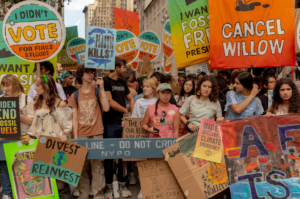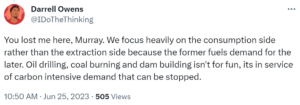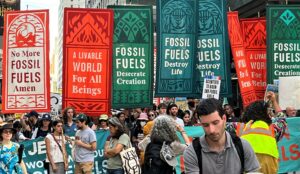Yesterday’s March to End Fossil Fuels in midtown Manhattan was big, loud and vibrant. The organizers put the tally at 75,000. While that may have been over-generous, the march was far and away the largest climate event in the U.S. in some time.
It was also an occasion to ponder the goals and tactics of the climate movement.
The customary signs and chants denouncing Big Oil and its funder banks were out in force. What felt new, and unsettling, was the vitriol directed at President Biden. Last year’s passage of the Inflation Reduction Act, with its promise to hasten the transition from fossil fuels by accelerating wind and solar and electrification, might as well have been an hallucination.

This photo by Sarah Blesener ran above the fold in the New York Times’ print edition the next day. The paper’s online caption caught the focus of the march: “Protest organizers used Sunday’s event to send a message to President Biden as he begins his push for re-election: Do more if you want our votes.”
Ganging Up On Joe
the signs and chants castigating the president flowed like a river. Biden: Declare a climate emergency … Cancel Willow … I didn’t vote for fires and floods.
Yikes. Whatever happened to the Inflation Reduction Act of 2022, with its nearly half-a-trillion dollars worth of tax credits and other subsidies paying down the cost of renewable electricity from solar and wind farms while also cutting consumer costs to purchase electric vehicles, electric heat pumps, and home and commercial electric battery storage?
The intent of the IRA’s myriad and synergistic incentives isn’t just to grow the U.S. green manufacturing base with good-paying green jobs. It’s to displace fossil-fuel use by substituting electricity for gasoline engines and gas-fired furnaces and simultaneously “greening the grid” by speeding the rate at which wind and solar power usurp electricity generation from coal and methane gas.
As the IRA was being enacted last August, energy analysts were estimating the potential carbon and methane reductions from those displacements, along with estimates of increased emissions from new federal oil and gas leasing that Biden committed to expedite to win the tie-breaking Yes vote from West Virginia Senator Joe Manchin. One think tank, Energy Innovation, concluded that “The bill’s clean energy measures will yield 24 times more emissions reductions than its fossil fuel provisions will increase emissions.” (The firm subsequently raised its 24-to-1 emissions ratio to 28-to-1.)
Seven months later, Biden issued a permit okaying ConocoPhillips’ $6 billion Willow oil-and-gas drilling venture on Alaska’s North Slope — and threw away the political good will due him from the IRA. Never mind that the additional carbon emissions from Willow’s hydrocarbon bounty will only negate a small fraction of the emission reductions from his legislation’s clean electricity and end-use electrification, as we pointed out back in March. Even more poignantly, those additional emissions are more properly estimated to be close to zero. Why? Because what actually burns the carbon fuels and puts the CO2 into the atmosphere is fossil fuel consumption, not supply. If Biden had rejected Willow, the same supply would have come from Nigeria, or Kuwait, or some other oil region or state. Supply is interchangeable. Demand is not.
In other words, Willow or any new U.S. drilling activity is nearly irrelevant from a climate standpoint because, as we wrote then, “demand finds a way to create supply,” rather than the reverse.
As we marched, I asked a smattering of anti-Biden sign-holders if the president merited praise for the green energy unleashed by his IRA, alongside or in place of criticism for okaying Willow or the Mountain Valley Pipeline through West Virginia. The typical response was No, we’re in a climate emergency. Any new fossil-fuel infrastructure is too much.
To be sure, trade-offs are hard to wrestle with even in calm moments, much less among a big crowd on the move. But the blank stares about the IRA and occasional flashes of venom against Biden were disquieting, nonetheless. The Times headline for its print report on the march was all too accurate: “Fingers Pointed at President, Protesters Demand End to Fossil Fuels.” Left unsaid is how much Biden-bashing America can withstand without placing our democracy as well as climate in irredeemable peril.
Who’s Really Funding Fossil Fuels?
If the anti-Biden sentiment was novel, the anti-big banks rhetoric was old hat. Blaming the climate crisis on Big Oil and demanding that universities, pension funds and the like “divest” by dumping fossil fuel securities from their holdings, has been a staple of climate organizing for nearly a dozen years, as I pointed out a year-and-a-half ago, in Exxon doesn’t care if you divest. Neither does climate:
When the writer and climate activist Bill McKibben kicked off the [divestment] campaign in a July 2012 Rolling Stone article, Global Warming’s Terrifying New Math, the rationale was three-fold: (1) dry up capital and make it harder for the fossil fuel industry to create new mines, wells, pipelines and terminals; (2) weaken the industry’s social and political standing so it couldn’t easily block pro-climate policy; and (3) by hanging a “Dump Me” sign around Big Oil, amp up climate organizing. Not for nothing did McKibben subtitle his Rolling Stone article, “Make clear who the real enemy is.” It was Exxon and its brethren.

A climate marcher with Third Act helpfully displayed the biggest U.S. banks’ fossil-fuel financing over the past seven years.
That path has proven to be a dead-end, I concluded in my post. One piece of evidence was a simple graph showing that Exxon-Mobil’s share price had outperformed the stock market as a whole since the onset of the Covid pandemic. More evidence, if any were needed, was available in the wonderfully wonky signboard at left that was borne by one of yesterday’s marchers, a vibrant senior citizen affiliated with the McKibben-inspired Third Act.
The amounts that the four banks — Chase, Citi, Bank of America, and Wells Fargo — have funneled into fossil fuels since the start of 2016 sum to an impressive-seeming $1.27 trillion ($1,270,000,000,000). Yet over the same period, consumption of petroleum products by U.S. families and businesses earned the oil companies a revenue haul nearly three-and-a-half times as great: an estimated $4.29 trillion ($4,290,000,000,000).
[I calculated that figure from the average 19.9 million barrels per day of gasoline, diesel fuel, jet fuel and other petroleum products kerosene and so forth consumed per day over the same seven years, 2016-2022. (See Energy Information Administration, Monthly Energy Review, Table 3.5 Petroleum Products Supplied by Type.) Factoring in (1) there are 42 gallons of petrol per barrel, (2) the seven years total 2,555 days (365 x 7), and 3) an average retail price per gallon sold of $2.00 — a conservative markdown from the actual $2.82 average retail price of gasoline over that period — yields $4.29 trillion.]
To be sure, this comparison has apples-and-oranges elements. Only some of the $4 trillion or more in petrol sales is available for investment in exploration and other petroleum infrastructure. And other banks beyond the Big Four also fund oil investment. On the other hand, U.S. consumption of the other fossil fuels — methane gas and coal — now exceeds consumption of petroleum on a Btu basis by 20 percent, suggesting that total fossil fuel revenue was probably in the vicinity of $8 billion rather than the $4.3 billion from petroleum products alone.
The point is that bank financing is a much thinner linchpin for creating new fossil fuel infrastructure than most climate activists suppose. What really makes fossil supply possible is the lock-in of consumption of fossil fuels themselves, in billions of routine purchases that, day in and day out, fork over many more dollars to the fossil fuel industry than do the banks.

(Owens was responding to a Cameron Murray, PhD, who was decrying the idea of asking Americans to take some responsibility for their personal carbon footprint.)
Or, as Darrell Owens, an analyst with CA YIMBY (Yes In My Back Yard), the pro-housing group that has spearheaded the recent revolution of expansionary zoning in California, put it recently on Twitter, “Oil drilling [and such] isn’t for fun, it’s in service of carbon intensive demand that can be stopped.”
Uprooting the Source: Carbon Consumption
Happily, some at the Climate March who saw beyond Biden and the banks, to the structures of consumption that enforce dependence on fossil fuels, whether directly at the gas pump or the furnace or stove, or indirectly in purchases of products whose manufacture and transportation entail massive quantities of fuel, or in inefficient or indulgent use of electricity, most of which is still made by burning coal or methane gas, and .
These included stalwarts from Citizens Climate Lobby, including an enthusiastic contingent from Pittsburgh as well as individuals from across the Northeast; and individuals whose handcrafted signs called out U.S. car culture not only for its gasoline profligacy but for its stifling of human life and health.

Some marchers saw beyond Biden and bankers to demand enduring solutions: carbon fee-and-dividend and liberation from automobiles.
“Tax Pollution, Pay People” packs so much into four words, I said to the sign-maker, a member of Citizens Climate Lobby from Pittsburgh, who told me his name, which I failed to write down. When I told him mine, he nearly jumped out of his shoes and shouted it to his fellow CCL’ers as if I was Greta Thunberg and Steelers legend Franco Harris rolled into one.
I started to apologize for CTC’s relative quiescence over the past year or two and to explain that I’ve been consumed with helping get NYC’s congestion pricing plan across the goal line. He stopped me short, thanking me for CTC’s work and insisting that, together, we’ll win a nationwide price on carbon before it’s too late.
So there’s my take. Singling out Biden for attack felt excessive and worrisome, since any falloff in enthusiasm will crimp the chances of democratic (small d) and climate-aware outcomes in the elections next year. Similarly, more than a decade’s worth of targeting Big Oil and the banks doesn’t appear to have moved the needle for effective climate policy. Going after “luxury carbon,” as Extinction Rebellion did in a small but resonant climate action last week in which I participated, feels to me like a more empowering path, one that might capture both the populist moment and climate urgency in a single stroke.
But notwithstanding the mis-directions, it was uplifting to be amidst tens of thousands with a like mind: A better world is possible. A better world is necessary. I want a fossil-free president. Amen to that!

<!–
–>
- SEO Powered Content & PR Distribution. Get Amplified Today.
- PlatoData.Network Vertical Generative Ai. Empower Yourself. Access Here.
- PlatoAiStream. Web3 Intelligence. Knowledge Amplified. Access Here.
- PlatoESG. Carbon, CleanTech, Energy, Environment, Solar, Waste Management. Access Here.
- PlatoHealth. Biotech and Clinical Trials Intelligence. Access Here.
- BlockOffsets. Modernizing Environmental Offset Ownership. Access Here.
- Source: https://www.carbontax.org/blog/2023/09/18/nyc-climate-march-unsettling-but-inspiring/




